
Pogona henrylawsoni – WELLS & WELLINGTON, 1985
(Pogona rankini, Pogona brevis)
(Pogona rankini, Pogona brevis)
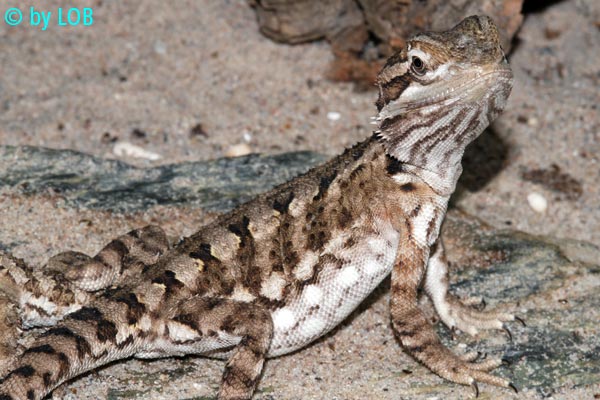
Pogona henrylawsoni: The smaller but more active species of the commonly kept bearded dragons • Die kleinere, aber aktivere Art der beiden häufig gehaltenen Bartagamen
© Lutz Obelgönner
© Lutz Obelgönner
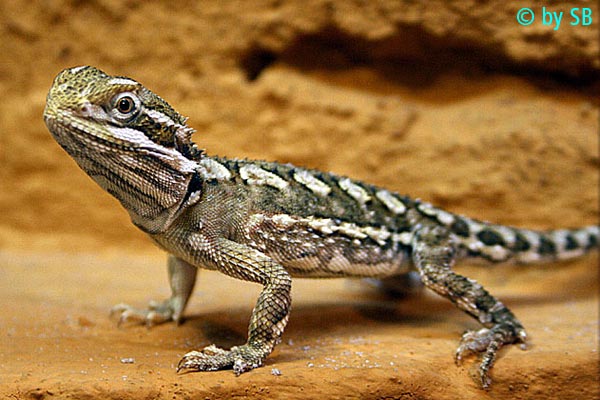
Pogona henrylawsoni: Adult captive-bred male • Adultes Nachzuchtmännchen
© Stefanie Bieker
© Stefanie Bieker
Black-soil / Dwarf Bearded Dragon
Description
A case for scientific disputes among taxonomists about the correct name which is referred as Pogona rankini, Pogona henrylawsoni or Pogona brevis. This is the smallest species of the Pogona genus and one which is kept in high numbers. Easy husbandry when some guidelines are followed. For example pure sand as substrate may leads to problems, because this species lives on clayey, firm ground in nature. High UV, temperature and space requirements due to high activity.
Protection
WA III, national laws Australia
Adult Size
28–30 cm
Lifespan
more than ten years
Distribution
central Queensland and parts of the Northern Territory
Habitat
stony steppe, dry forests and semi-arid areas, sparse vegetation
Captive Care
At least 120x60x60 cm WDH. Animals make use of heigth if you provide structures. Temperature 28–32 °C, basking spot 45 °C, night temperature 20–22 °C, humidity 40–50 %. Spray twice a week. Daylight fluorescent lamps or LED, HQL or HQI spot, rock structures and some rough branches, rocky back wall, water bowl, food plate. Ground sand/clay mix.
Food
Insects and larvae, pre-made dragon food, vegetarian food plus vitamins/minerals (e. g. Herpetal Complete). Juveniles need carnal/vegetarian diet in 80:20 ratio, adults vice versa. Herbs are the best vegetables (e.g. dandelion, rough hawkbit, plantain, clover). If you must feed salat than choose the bitter types (ruccola, chicory etc.). A good indication for the right choice of vegies are the faeces, they should be rather dry and crumbly instead of wet and mushy. See chapter forage plants on the feeding site (not finished yet).
Reproduction and Rearing
Keep pairs, additional females possible. Pair only adult, healthy animals. Several clutches of 10–20 eggs will be deposited in high (about 15 cm useful), lightly moist mix of clay and sand. Incubation at about 28–30 °C for 50–70 days.
A case for scientific disputes among taxonomists about the correct name which is referred as Pogona rankini, Pogona henrylawsoni or Pogona brevis. This is the smallest species of the Pogona genus and one which is kept in high numbers. Easy husbandry when some guidelines are followed. For example pure sand as substrate may leads to problems, because this species lives on clayey, firm ground in nature. High UV, temperature and space requirements due to high activity.
Protection
WA III, national laws Australia
Adult Size
28–30 cm
Lifespan
more than ten years
Distribution
central Queensland and parts of the Northern Territory
Habitat
stony steppe, dry forests and semi-arid areas, sparse vegetation
Captive Care
At least 120x60x60 cm WDH. Animals make use of heigth if you provide structures. Temperature 28–32 °C, basking spot 45 °C, night temperature 20–22 °C, humidity 40–50 %. Spray twice a week. Daylight fluorescent lamps or LED, HQL or HQI spot, rock structures and some rough branches, rocky back wall, water bowl, food plate. Ground sand/clay mix.
Food
Insects and larvae, pre-made dragon food, vegetarian food plus vitamins/minerals (e. g. Herpetal Complete). Juveniles need carnal/vegetarian diet in 80:20 ratio, adults vice versa. Herbs are the best vegetables (e.g. dandelion, rough hawkbit, plantain, clover). If you must feed salat than choose the bitter types (ruccola, chicory etc.). A good indication for the right choice of vegies are the faeces, they should be rather dry and crumbly instead of wet and mushy. See chapter forage plants on the feeding site (not finished yet).
Reproduction and Rearing
Keep pairs, additional females possible. Pair only adult, healthy animals. Several clutches of 10–20 eggs will be deposited in high (about 15 cm useful), lightly moist mix of clay and sand. Incubation at about 28–30 °C for 50–70 days.
Zwergbartagame
Generelles
Ein Fall für Namensstreit unter den Taxonomen: Die Zwergbartagame, kleinste Art der Gattung Pogona, wird als Pogona rankini, Pogona henrylawsoni oder Pogona brevis bezeichnet. Neben Pogona vitticeps die zweite Art, die häufig und relativ leicht zu halten ist, wenn grundsätzliche Parameter beachtet werden. So ist reiner Sand als Bodengrund z.B. nicht angebracht, weil die Tiere in der Natur auf stark tonhaltigem, festem Untergrund leben. Großer Sonnen-, Wärme- und Platzbedarf durch hohe Aktivität.
Schutzstatus
WA III, nationale Gesetzgebung Australien
Größe
28–30 cm
Lebenserwartung
mindestens zehn Jahre
Vorkommen
zentrales Queensland und Teile des Northern Territory
Habitat
semiaride, steinige Steppen, Trockenwälder, wenig Vegetation
Haltung
Mindestens 120x60x60 cm BTH. Höhe wird bei entsprechenden Strukturen genutzt. Temperatur tags 28–32 °C, Sonnenplatz 45 °C, nachts 20–22 °C, Luftfeuchtigkeit 40–50 %, zweimal wöchentlich sprühen. Tageslichtleuchtstoffröhren oder LEDs, HQL- oder HQI-Strahler, Bodengrund Sand-Lehm-Gemisch, Wassergefäß, Futterteller, Steinaufbauten, Felsrückwand, grobe Äste. Lebenserwartung mind. 10 Jahre.
Futter
Insekten und Larven, fertiges Bartagamenfutter, vegetarische Kost plus Vitamine/Mineralien (z. B. Herpetal Complete). Jungtiere benötigen tierische und pflanzliche Kost im Verhältnis von etwa 80:20, bei Adultis kehrt sich das Verhältnis bei um. Bei den Futterpflanzen sind Kräuter (Löwenzahn, Wegerich, Klee etc.) gegenüber Salaten zu bevorzugen, bei den Salaten besser die bitteren Sorten (Endivie, Römersalat, Ruccola) verfüttern. Ein gutes Zeichen für die richtige Nahrung ist der Kot. Ist dieser eher fest und krümelig, stimmt die Mischung, ist er eher matschig, sollte der vegetarische Anteil verändert werden. Mehr Infos unter Futterpflanzen auf der Seite Futter (noch nicht bearbeitet).
Zucht und Aufzucht
Paarhaltung oder besser mehrere Weibchen. Nur adulte, gesunde Tiere verpaaren. Mehrere Gelege pro Jahr möglich, meist 10–20 Eier. Ablage in hohem (15 cm sinnvoll), leicht feuchtem Sand-Lehm-Mix. Inkubation bei 28–30 °C für 50–70 Tage.
Ein Fall für Namensstreit unter den Taxonomen: Die Zwergbartagame, kleinste Art der Gattung Pogona, wird als Pogona rankini, Pogona henrylawsoni oder Pogona brevis bezeichnet. Neben Pogona vitticeps die zweite Art, die häufig und relativ leicht zu halten ist, wenn grundsätzliche Parameter beachtet werden. So ist reiner Sand als Bodengrund z.B. nicht angebracht, weil die Tiere in der Natur auf stark tonhaltigem, festem Untergrund leben. Großer Sonnen-, Wärme- und Platzbedarf durch hohe Aktivität.
Schutzstatus
WA III, nationale Gesetzgebung Australien
Größe
28–30 cm
Lebenserwartung
mindestens zehn Jahre
Vorkommen
zentrales Queensland und Teile des Northern Territory
Habitat
semiaride, steinige Steppen, Trockenwälder, wenig Vegetation
Haltung
Mindestens 120x60x60 cm BTH. Höhe wird bei entsprechenden Strukturen genutzt. Temperatur tags 28–32 °C, Sonnenplatz 45 °C, nachts 20–22 °C, Luftfeuchtigkeit 40–50 %, zweimal wöchentlich sprühen. Tageslichtleuchtstoffröhren oder LEDs, HQL- oder HQI-Strahler, Bodengrund Sand-Lehm-Gemisch, Wassergefäß, Futterteller, Steinaufbauten, Felsrückwand, grobe Äste. Lebenserwartung mind. 10 Jahre.
Futter
Insekten und Larven, fertiges Bartagamenfutter, vegetarische Kost plus Vitamine/Mineralien (z. B. Herpetal Complete). Jungtiere benötigen tierische und pflanzliche Kost im Verhältnis von etwa 80:20, bei Adultis kehrt sich das Verhältnis bei um. Bei den Futterpflanzen sind Kräuter (Löwenzahn, Wegerich, Klee etc.) gegenüber Salaten zu bevorzugen, bei den Salaten besser die bitteren Sorten (Endivie, Römersalat, Ruccola) verfüttern. Ein gutes Zeichen für die richtige Nahrung ist der Kot. Ist dieser eher fest und krümelig, stimmt die Mischung, ist er eher matschig, sollte der vegetarische Anteil verändert werden. Mehr Infos unter Futterpflanzen auf der Seite Futter (noch nicht bearbeitet).
Zucht und Aufzucht
Paarhaltung oder besser mehrere Weibchen. Nur adulte, gesunde Tiere verpaaren. Mehrere Gelege pro Jahr möglich, meist 10–20 Eier. Ablage in hohem (15 cm sinnvoll), leicht feuchtem Sand-Lehm-Mix. Inkubation bei 28–30 °C für 50–70 Tage.
Literature / Literatur
Delport, R. The Advanced Bearded Dragon Manual (link to e-book)
Dieckmann, M. (2007). Die Zwergbartagame – Pogona henrylawsoni. NTV, Münster.
Freynik, C. (2007). Die Zwergbartagame – Pogona henrylawsoni. Vivaria, Meckenheim.
Köhler, Gunther & Karsten Grießhammer & Norbert Schuster (2003): Bartagamen: Biologie, Pflege, Zucht, Erkrankungen. Herpeton, Offenbach.
Müller, P. M. (2005). Bartagamen – die Gattung Pogona (Storr, 1982). Draco 22: 4–19. NTV, Münster.
Delport, R. The Advanced Bearded Dragon Manual (link to e-book)
Dieckmann, M. (2007). Die Zwergbartagame – Pogona henrylawsoni. NTV, Münster.
Freynik, C. (2007). Die Zwergbartagame – Pogona henrylawsoni. Vivaria, Meckenheim.
Köhler, Gunther & Karsten Grießhammer & Norbert Schuster (2003): Bartagamen: Biologie, Pflege, Zucht, Erkrankungen. Herpeton, Offenbach.
Müller, P. M. (2005). Bartagamen – die Gattung Pogona (Storr, 1982). Draco 22: 4–19. NTV, Münster.
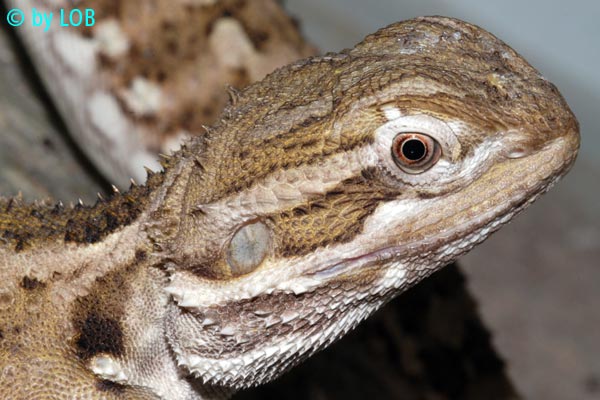
Pogona henrylawsoni: Semiadult captive-bred specimen • Halbwüchsiges Nachzuchttier
© Lutz Obelgönner
© Lutz Obelgönner
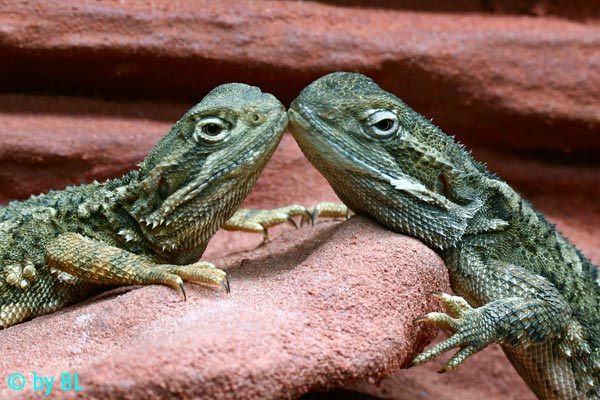
Pogona henrylawsoni: Adult breeders, male on the right • Zuchtpärchen, Männchen rechts
© Bianca Lang
© Bianca Lang
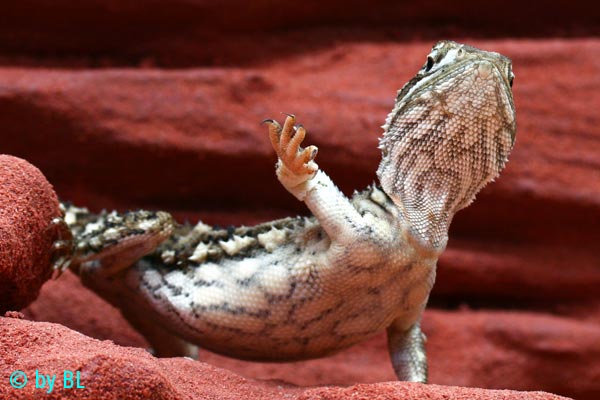
Pogona henrylawsoni: Female (left) and male (right) clearly indicate it's their territory even to the observer.
© Bianca Lang
© Bianca Lang
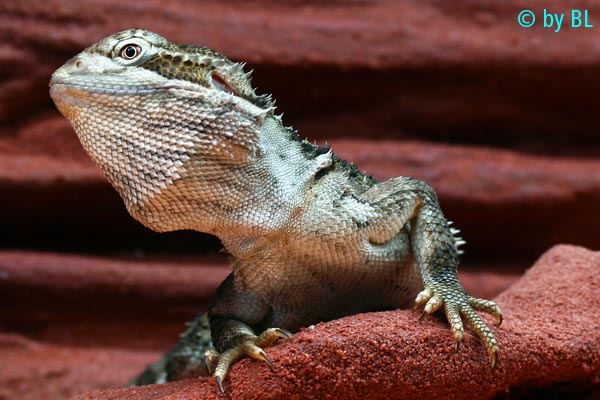
Pogona henrylawsoni: Weibchen (links) und Männchen (rechts) zeigen auch dem Betrachter ganz eindeutig, dies ist ihr Revier.
© Bianca Lang
© Bianca Lang
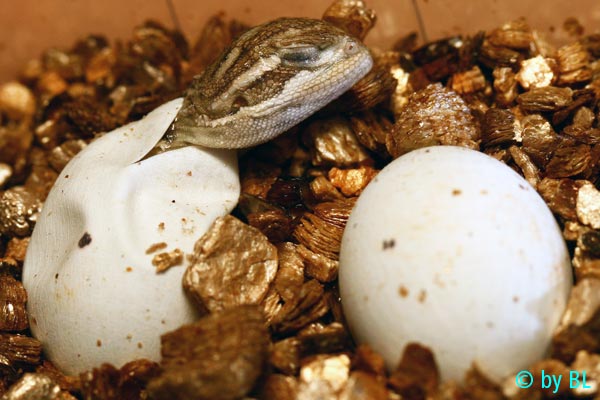
Pogona henrylawsoni: Hard struggle to get out of the egg shell • Der Weg aus dem Ei ist beschwerlich.
© Bianca Lang
© Bianca Lang
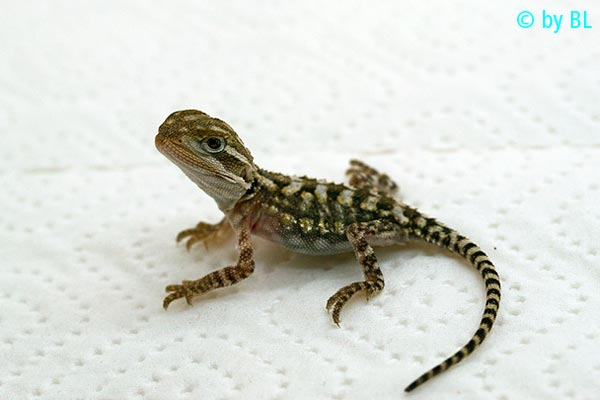
Pogona henrylawsoni: Hatchling • Schlüpfling
© Bianca Lang
© Bianca Lang
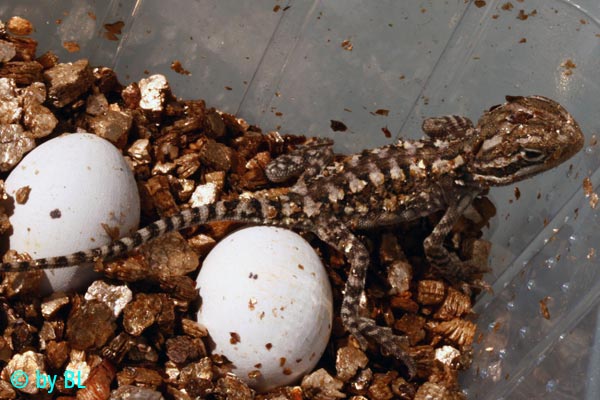
Pogona henrylawsoni: Made it eventually ... • Endlich geschafft …
© Bianca Lang
© Bianca Lang
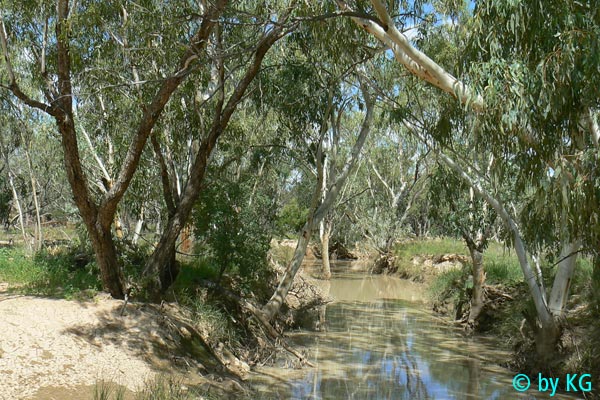
Pogona henrylawsoni: Habitat near Winton (Queensland) • Biotop nahe Winton (Queensland)
© Karsten Grießhammer
© Karsten Grießhammer
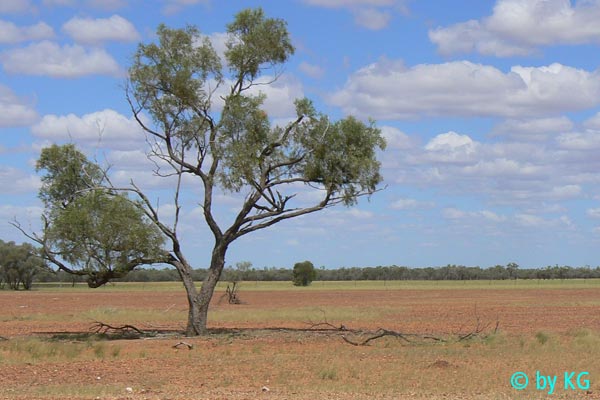
Pogona henrylawsoni: Habitat near Winton (Queensland) • Biotop nahe Winton (Queensland)
© Karsten Grießhammer
© Karsten Grießhammer